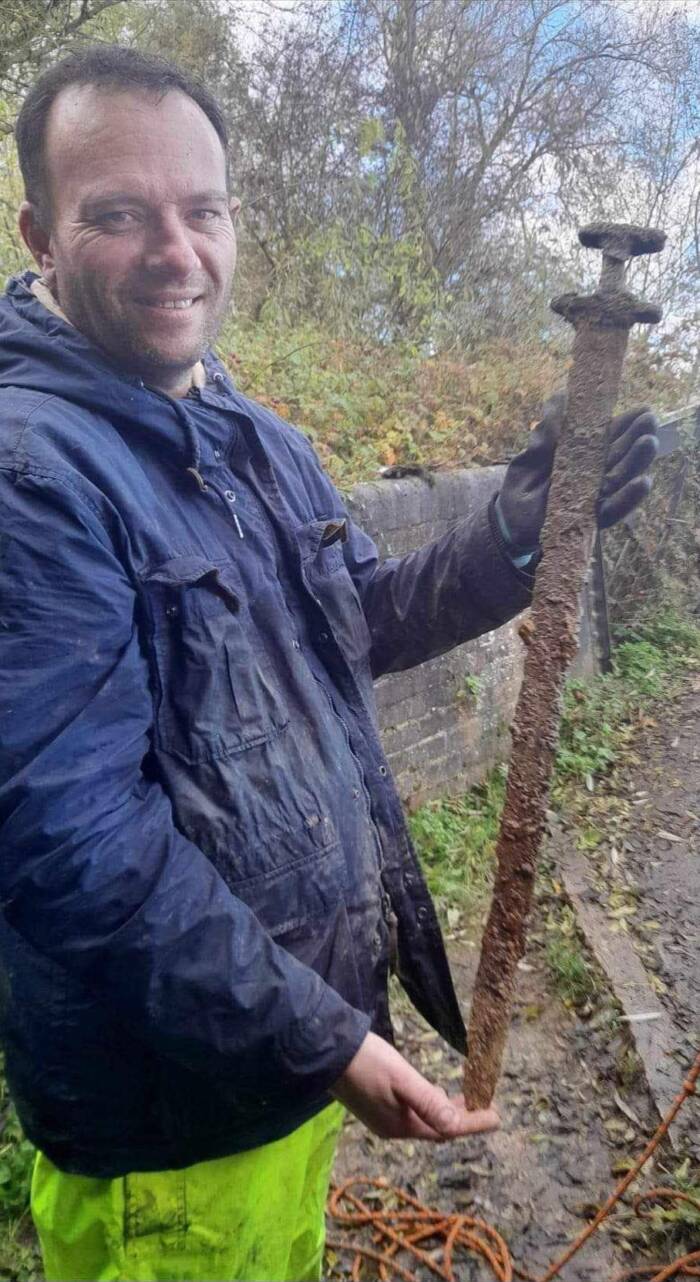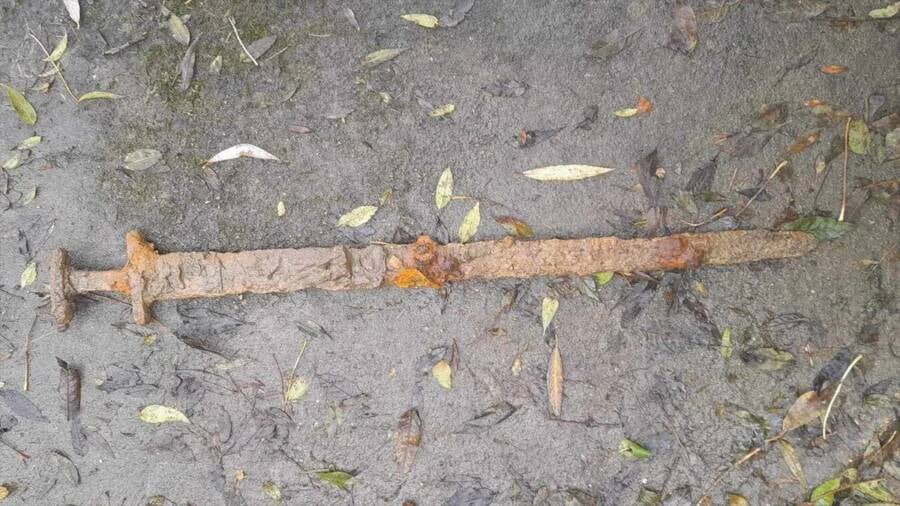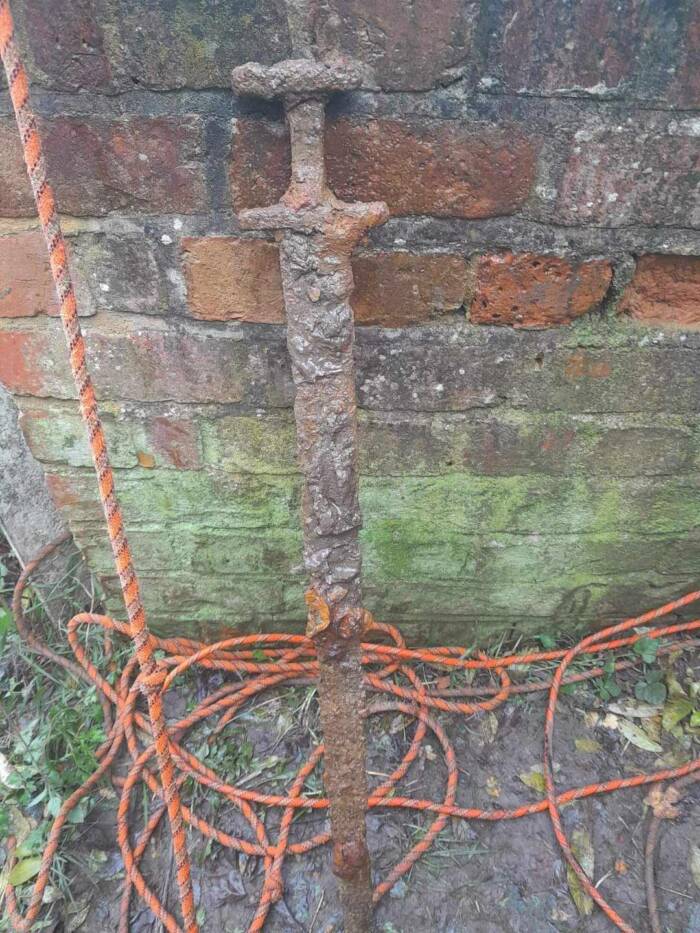The sword dates back to between 850 and 975 C.E. and is in remarkably good condition.

Trevor PennyMagnet fisher Trevor Penny with the Viking sword that he found in November 2023.
Trevor Penny went to the River Cherwell in Oxfordshire last November with plans to go fishing — but not for fish. Penny, a magnet fisher, cast a powerful magnet into the river’s waters in hopes of luring in metal objects. He soon pulled up a remarkable item: a 1,100-year-old Viking sword.
The sword, which was just authenticated, is certainly a thrilling find. But the British Museum has cautioned others from following Penny’s lead.
Discovering The Sword In River Cherwell
In November 2023, Trevor Penny — a member of the Thame Magnet Fishing group — trundled down to River Cherwell in Oxfordshire to do some magnet fishing. This pastime involves tossing a powerful magnet into the water in hopes of pulling up metal objects, which might include poles, old signs, pots and pans, and even weapons like guns or bombs.
Initially, Penny didn’t find much. According to Live Science, he only pulled up a couple of scaffolding poles at first. But then he cast his magnet into the river again — and reeled in a much more intriguing object.

Trevor PennyThe Viking sword found by Penny, which is over 1,000 years old.
“I was on the side of the bridge and shouted to a friend on the other side of the bridge, ‘What is this?'” Penny explained to Live Science about his discovery. “He came running over shouting, ‘It looks like a sword!'”
In a Facebook message with All That’s Interesting, Penny added: “I was shocked when I first saw it & couldn’t believe it.”
Penny uploaded images of the sword to Google, which suggested it came from the Viking age. He then contacted the Oxfordshire county liaison officer, an official responsible for recording archaeological discoveries made by the public, who seconded Google’s suggestions.
“He said straight away, it looks Viking,” Penny told All That’s Interesting.
The official had the sword examined by professionals, who confirmed that the sword had once belonged to the Vikings.
A Remarkable Object From The Viking Age
Over 1,000 years old, the Viking sword was subsequently dated to between 850 and 975 C.E.
“It really did feel quite amazing — it’s the oldest thing found in this county magnet fishing,” Penny told the Oxford Mail. “The officer said it was archaeologically rare to find whole swords and treasure of historical importance still intact. It was a proud moment to find it.”

Trevor PennyThe Viking sword was dated to between 850 and 975 C.E., placing it in the midst of the Viking era in the British Isles.
Indeed, the sword fits snugly within the Viking era in the British Isles. The period began in earnest in 793 C.E., when Vikings sailed to Lindisfarne, an island off Britain’s northeast coast, and attacked a monastery. Viking raids continued — and escalated — as the centuries passed until the Saxons defeated the king of Norway, Harald III Sigurdsson, at the Battle of Stamford Bridge in 1066.
Though there was a tussle between Penny, the landowner, and River Trust, which does not permit magnet fishing, the parties came to an amicable conclusion. Penny told the Oxford Mail that the River Trust would not take legal action if the sword was given to a museum, which he agreed to do.
That way, the public can enjoy Penny’s remarkable discovery. However, the British Museum has warned other treasure seekers against magnet fishing in recent months.
“‘Fishing’ for metal objects with powerful magnets in lakes and waterways has become increasingly popular,” experts from the Portable Antiquities Scheme (PAS) run by the British Museum said, according to The Telegraph. “However, there are many risks involved, including finding unexploded ordnance and possibly drowning.”
They added that magnet fishing also risks damaging metal objects and is “banned by the Canal and River Trust on its waterways.”
That said, Penny’s discovery — like the discoveries made by amateur metal detectorists — just goes to show that history is all around us, even when it’s sunk in a river or buried deep in the soil.
After reading about the Viking sword found by a magnet fisher in Oxfordshire, look through these fascinating facts about the Vikings. Or, discover the surprising truth about Viking helmets, which likely looked very different from how they’re depicted in popular culture.





